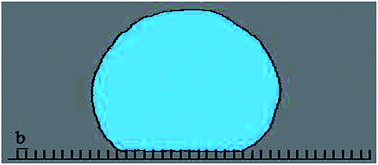Cassie–Baxter to Wenzel state wetting transition: a 2D numerical simulation
Abstract
We simulate in two dimensions the wetting behavior of a liquid droplet placed on a solid surface structured by a regular distribution of pillars. For this purpose, as in a recent study, we used the Potts Hamiltonian formalism. We focused our investigations on the transition between the wetting regimes characteristic of the super-repellent property of our surfaces. We determined several physical variables influencing such a property and we also built the wetting phase diagrams of which two different states and a transition zone were identified. The transition happens between a Cassie–Baxter state (CB) and the Wenzel state. We also show that the wetting transition is affected by fluctuations and liquid compressibility.


 Please wait while we load your content...
Please wait while we load your content...